
 |
Harrison Eiteljorg, II
CAD models do not stand on their own. Whether the information required to understand a given model is widely known or the province of a small number of scholars, intelligent use of the model requires access to information about materials, building phases, building procedures, surface treatments that imply re-use or change during the building process, and a host of other matters. As a result, it is important to connect to CAD models information that is needed to help explain the models. Such information is not limited to lengthy expository material or documentation of CAD procedures but may include databases that, for example, contain information about building materials or phases; connected information may also include shorter text passages that contain comments about specific features, interpretations, notes made during the initial examination/excavation, and so on. In short, CAD models need context information that can travel with them.
Some years ago it became possible to attach database information to models in various CAD programs, and there have been discussions of this feature in AutoCAD® in CSA Newsletter articles. (See "AutoCAD 2000 - A Review," Harrison Eiteljorg, II, Fall, 2000, vol. XIII,. no.2; http://www.csanet.org/newsletter/fall00/nlf0009.html and "AutoCAD Release 14 - A Review," Harrison Eiteljorg, II, Winter, 1998, vol. X, no. 3; http://www.csanet.org/newsletter/winter98/nlw9802.html and "AutoCAD Release 13," H. Eiteljorg, II, August, 1996, vol. IX, no. 2; http://www.csanet.org/newsletter/aug96/nl089612.html.) MiniCad® also has a connected database feature, as discussed in "MiniCad 6 - Another View," Paul C. Zimmerman, November 1996, vol. IX, no. 3; http://www.csanet.org/newsletter/nov96/nl119609.html.) There is a common theme in the AutoCAD articles. Each new version seems to present new and annoying difficulties with the database connections.
As discussed in another article in this issue of the CSA Newsletter ("CAD Archival Preservation - and Some Practical Consequences" by Harrison Eiteljorg, II), there are theoretical problems with incorporating information other than geometry and layering into CAD models. File migration requires translation of data from one format to another, and some CAD formats are so proprietary that the contents of files may not always translate well. Links to external database files are among the kinds of data that are held in proprietary formats and may not translate correctly. Furthermore, using the proprietary connections between CAD models and external data files has been difficult even when moving simply from one version of a CAD package to the next. In fact, CSA will no longer use any proprietary data connection scheme. It is too troublesome. However, links from CAD models to database information and/or text notes are too valuable to be lost; so an alternative has been developed.1
What follows is CSA's system for connecting external data and/or text files to CAD models. Since this is a proposal for use by other scholars, readers' comments will be greatly appreciated. The intent is to provide a relatively simple system that will have a visual component so that users can recognize where there are links to database or textual information. The system should also be easy to use, requiring little computer expertise beyond that assumed for a CAD model-maker.
One component of this system will be either a database file or a simple word-processing file -- or both. Of course, a database file can be used for either text or tabular information; a word-processing file should only be used for simple text notes. The database file must have a key field to permit unambiguous connections to model information; similarly, the text file should have a header for each note that will connect the note unambiguously to the proper item(s) in the model. The word-processing file can be in any format, as can the database file. However, both should be prepared so that export to non-proprietary formats will not cause any loss of information.
The other side of this coin must be something in the model that can display the links from items in the drawing to the proper information in the word-processing file or the proper record (row) in the data table. In order to make the links both clear and inconspicuous -- and to make sure the links are not in some obscure proprietary format -- the linkage will be indicated by simply drawing standardized tokens on special layers. If those token are the only things on their layers, the layers could be turned off without affecting anything else in the model. That is, all the actual building or excavation parts will exist on the normal layers for such things, separate from those layers that have the tokens to indicate data connections. Turn off the data connection layers, and only the model itself will show. Turn some or all of the data connection layers on, and the data connections will be on display via the tokens -- with or without the other portions of the model, as the user wishes.
This procedure is best illustrated with a concrete example; so the CSA standard "test bed" for new CAD ideas, the older propylon model, will be used to illustrate the procedures. In order to make all the illustrations large enough to be truly useful, each must be accessed as a separate, large image. Each will be brought up in its own window.
The information about individual blocks in the model can be stored in a database such as the one illustrated in Fig. 1.
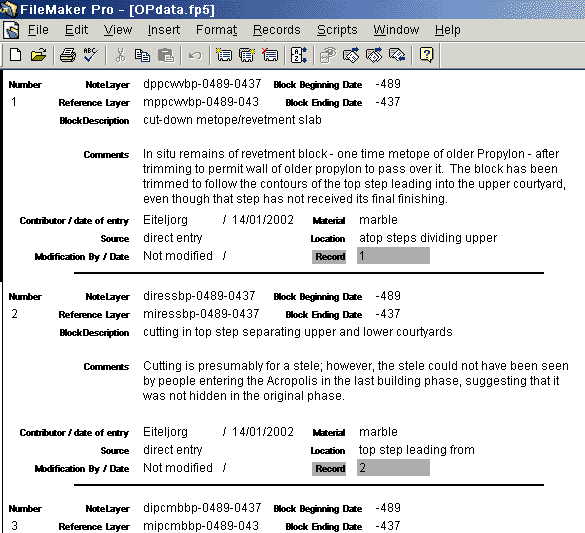
Only the first two records and part of the third are shown from a FileMaker® database file. Part of the FileMaker window is illustrated. (Please note that all the illustrations here may seem somewhat truncated, but they have been kept as small as possible to accommodate readers who use relatively low-resolution monitors.)
Other relevant information about the older propylon, in the form of simple text divided into a series of individual notes, is shown in Fig. 2.
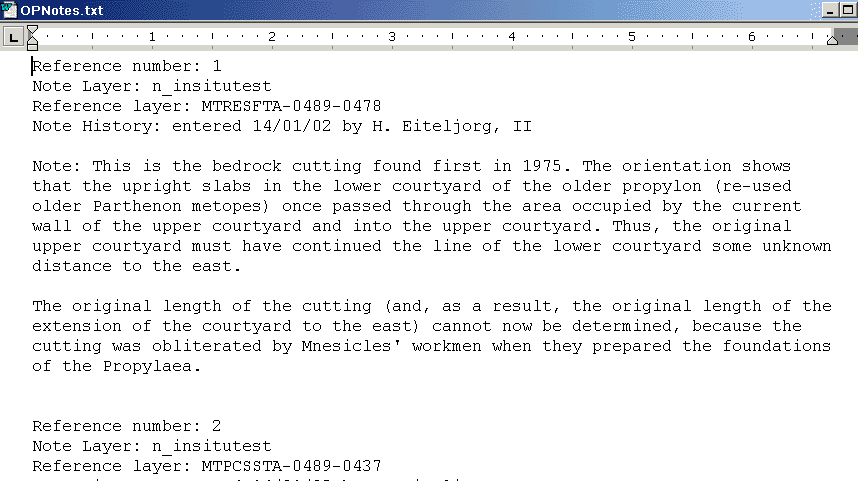
In this case, part of an MS Word® window is shown; only one note and part of a second can be seen. Observant readers will note that the file on display has been stored in TXT format, not Word's native DOC format. There are no text appearance issues that require a more complex format; so TXT is the most universal for such a purpose.
The information shown in Figs. 1 and 2 should be connected to the older propylon model. These are the kinds of facts that are not made clear by either the model geometry or the layer-naming system. They are, however, important pieces of information that would help anyone reach a better understanding of the older propylon. As they stand, without a connection to the model, though, the items of information are not particularly helpful.
Fig. 3 shows the parts of the model to which these informational items belong - the in situ portions of the first construction phase.
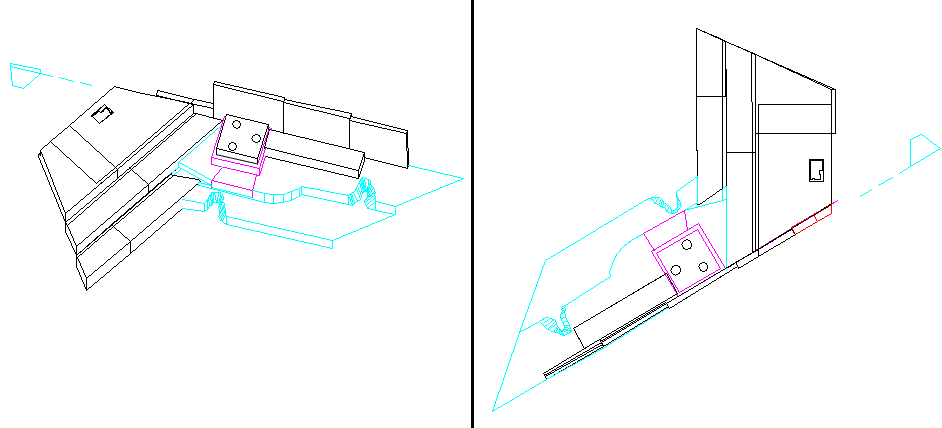
Someone very familiar with the model might be able to determine which blocks or portions of the model are being described in the database and text entries, but the point is to make the information clear to any user. Therefore, some new layers have been added to the model, and those layers have the tokens that show the links to database and note information. Those new layers have been turned on in Fig. 4.
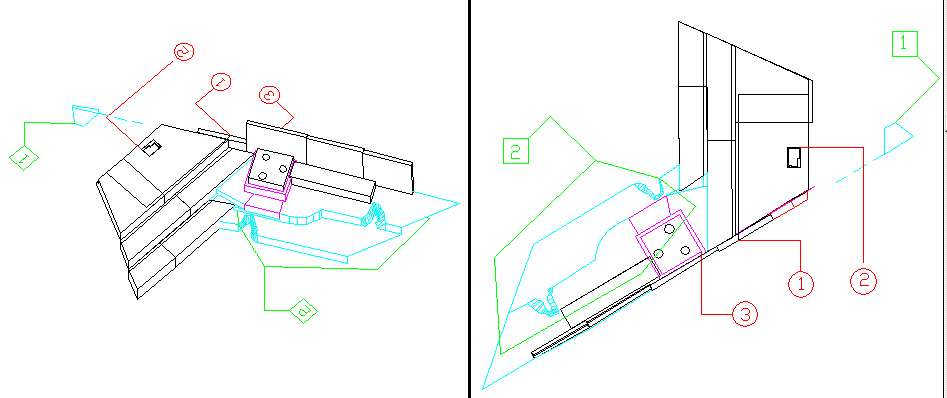
There you can see the two different kinds of tokens, one consisting of horizontal and vertical lines leading from a specific point in the model (a point that is part of an object) to a circle with a number in it and the other consisting of lines at a 45-degree angle from the horizontal or vertical and leading from the boundary outlining the area of interest to a square with a number in it.
The encircled numbers refer to database entries, and the numbers enclosed in squares refer to notes. The encircled numbers (referring to database records) are colored red; the numbers in squares (referring to notes) are in a light a light green to distinguish them from actual model parts, but the colors are so easily changed in a CAD model that they are best used only for temporary effects.
Fig. 5 shows the same view of the model, but with only the layer showing tokens for notes. In addition, the MS Word window with the notes is showing, making it possible to refer to the note and the relevant portion of the drawing at the same moment. Both MS Word and AutoCAD must be running for the data and the CAD model to be seen together. Fig. 6 shows the model with the database information. In this instance, both FileMaker and AutoCAD must be running at the same time.
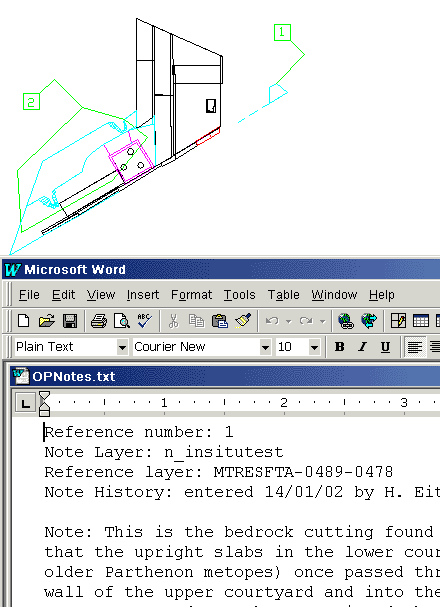
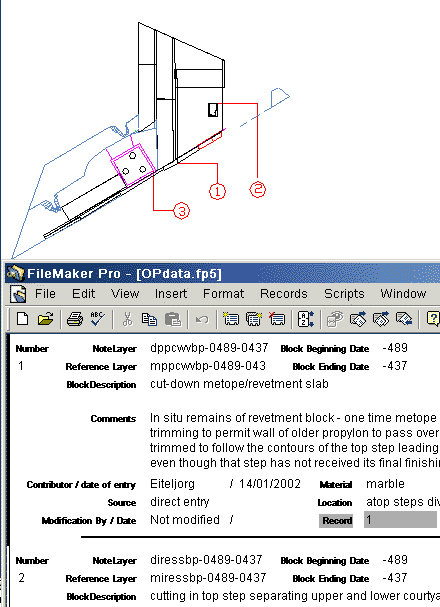
Using the model -- with specifically named layers to contain data links (in this case, d in the first position of the layer name to indicate a database link and n to indicate a note) -- permits the user to see clearly what database items or notes are available. Using the data or text files, on the other hand, shows clearly where visual information will be found, since the layer names are included there.
This way of connecting external data to the CAD model is less interactive than the built-in systems supplied by CAD vendors, but it is much more robust and requires neither specific CAD programs nor special database managers. The information can be seen clearly and unambiguously, and the files required can easily be changed from one format to another without affecting the data or the inter-connections. It will be the system used by CSA in the future.
This form of database linkage has obvious utility for excavators who want to connect external data to CAD models. An individual data file or table, in the case of a relational database, can be connected to the model, providing the link, but the full power of the relational database is connected in the process. Thus, a CAD model of an excavation, with a link between excavation units in the model and those units in a complex relational database, could lead a user directly from the CAD model to a database view of all the finds from a specific excavation unit. Once again, this system would be very robust and would require no translation or migration as software packages change.
A system functioning identically to the one described here could appear quite different. The shape and size of tokens, for instance, are not important. What is important is a careful set or rules and procedures that combines specific layers for tokens, well-defined tokens, a fully-specified connection between the tokens and the items references, and carefully-constructed external text or database files. The utility of the system lies in its flexibility and robustness.
-- Harrison Eiteljorg, II
To send comments or questions to the author, please see our email contacts page.
1. In the very long run, the merging of CAD and GIS technologies may produce robust connections between data and CAD models, because the GIS links are built upon standard database key fields. In the meantime, however, users of CAD need an efficient, reliable, robust, easily transferable mechanism for attaching database or text information to a model. Return to body of text.
For other Newsletter articles concerning the applications of CAD modeling in archaeology and architectural history, the "CSA CAD Layer Naming Convention," the ADAP and issues surrounding digital archiving, or the use of electronic media in the humanities consult the Subject index.
Next Article: The Way Your Computer Handles Text is Changing
Table of Contents for the Winter, 2002 issue of the CSA Newsletter (Vol. XIV, no. 3)
 Table of Contents for all CSA Newsletter issues on the Web
Table of Contents for all CSA Newsletter issues on the Web
| CSA Home Page |